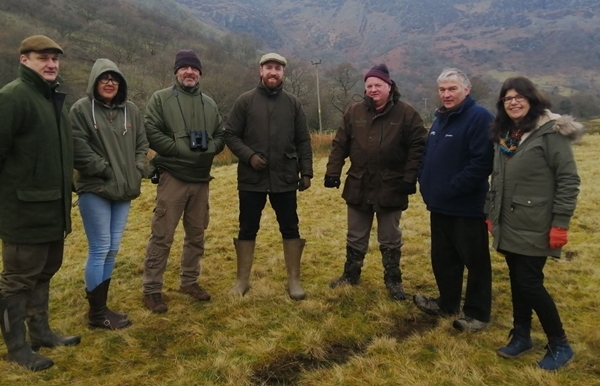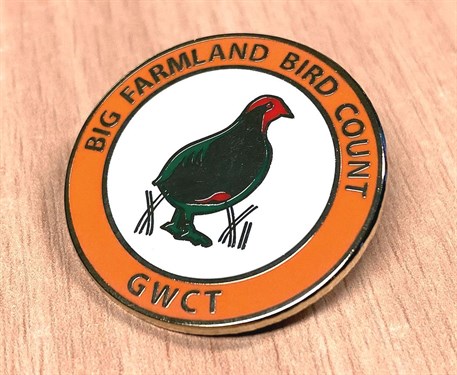
More birdlife than ever, is how Hedd Pugh describes bird numbers on his beef and sheep farm in the Cwm Cywarch valley of south Snowdonia in Dinas Mawddwy, near Machynlleth last Friday at the Big Farmland Bird Count launch.
Orchestrated by the Game & Wildlife Conservation Trust Wales, and sponsored by NFU Cymru, Hedd’s role as Rural Affairs board chairman believes that the farm has only gained in bird numbers as he has embraced all the Welsh environmental schemes such as Tir Cymen in 1992 followed by the subsequent schemes, Tir Gofal and Glastir which has helped him create more wildlife corridors with masses of hedge and tree planting, double fencing of hedges and streams etc.
Matt Goodall is the GWCT Wales advisor who has visited a number of farms over the past week to prepare in the citizen science initiative to promote what farmers are doing to help birds at this tricky time of year, known as the ‘hungry gap’ months - December to May - where food supplies are scarce but vital to help breeding success.
“We need to know what is succeeding and which bird species needs more help,” says Matt, who is clear that birds not only need protecting by the warmth of the shelter belts but supplementary feeding is also crucial.
“They need all the help we can give them and that can quite often mean just small changes at field scale,” he says, adding that feed hoppers are a great example of something that is an easy way to make sure there if food available immediately. He also points out that although this is an option available in Glastir, its low uptake was down to it being poorly promoted instead of being actively encouraged.
Glenda Thomas, from the Farming & Wildlife Advisory Group Cymru, who has worked on conservation with Hedd since Ty Cymen stresses the need for the next Farming scheme to incentivise farmers to put in more cover crops over the winter to help the birds, and for more varieties of wild seed mix to be included so that birds are in good health before the breeding season.
“Environmental schemes to date have fallen short on this account but an opportunity to recognise and realistically award farmers for growing crops important for birds, insects etc now presents itself when the new scheme is designed.”
Hedd has kept with the traditional breeds of beef and sheep which are well suited to his farm’s tough climate which, although only at 500 ft above sea level at the farmstead, quickly ascends to 2900 feet around him.
Hereford cross suckler cows and Welsh mountain hefted sheep are the cornerstone breeding platform for the lowland breeders which is a skill that is of risk of disappearing in the next generation as farmers are being encouraged to reduce stocking rates, explains Hedd, adding that cattle grazing has huge benefits to soil health & biodiversity which must be part of the next schemes design.
“We are seeing a huge volume of breeding birds here as the fruits of all the planting carried out here over the past 30 years becomes visible,” says Hedd, who says the spring sees an explosion of migratory birds, including the rare pied flycatcher which have been encouraged by putting up bird boxes. He believes that more will come as the wider, more dense wildlife corridors mature providing insect rich habitats for more bird species to feed.
NFU President Minette Batters welcomes the initiative: “It’s an opportunity for farmers to take pride in what they find on their land,” she says, adding that alongside food production, without sound management of the environment, enhancing of habitats, protection of wildlife and support for pollinators and soils, we do not have farming businesses.
“I would encourage all farmers to take part in this year’s count and submit the records to the GWCT, so we can pull together a vital national snapshot of the state of nation when it comes to farmland birds.”
Please get involved in your own farmland bird count now and get the results uploaded so we start to see what birds are responding to the conservation efforts being made by so many Welsh farmers www.bfbc.org.uk.
How to take part
Download a count sheet from www.bfbc.org.uk and count your birds! On a day between February 7 and 16, spend about 30 minutes recording the species and number of birds seen in one particular area, aiming for approximately 5 acres. Once completed, submit results at www.bfbc.org.uk.

Get your GWCT Big Farmland Bird Count Badge for £5.00
Limited edition - only 250 produced
Show your support for the Game & Wildlife Conservation Trust's Big Farmland Bird Count, taking place in February.
View Badge >
or
Buy Badge Now >
100% Secure. All Credit & Debit cards, PayPal, Apple Pay and Google Pay accepted.

Notes to editors
The Game & Wildlife Conservation Trust – providing research-led conservation for a thriving countryside. The GWCT is an independent wildlife conservation charity which has carried out scientific research into Britain’s game and wildlife since the 1930s. We advise farmers and landowners on improving wildlife habitats. We employ 22 post-doctoral scientists and 50 other research staff with expertise in areas such as birds, insects, mammals, farming, fish and statistics. We undertake our own research as well as projects funded by contract and grant-aid from Government and private bodies. The Trust is also responsible for a number of Government Biodiversity Action Plan species and is lead partner for grey partridge and joint lead partner for brown hare and black grouse.
For information, contact:
Eleanor Williams
Telephone: 07592 025476
Email: press@gwct.org.uk